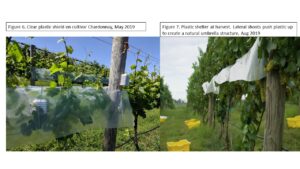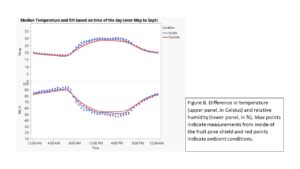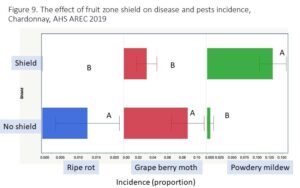Project Overview
Commodities
- Fruits: grapes
Practices
- Pest Management: chemical control, physical control, prevention
Abstract:
Encouraged by the results from bagging experiments, our lab has been experimenting with another type of protection using a sheet of plastic (Fig. 6). We placed a sheet of 4 Mil plastic (Uline Poly Sheeting S-5853) approximately 18 inches in length to cover the area between the first catch wire (typically placed approximately 18 inches above the fruiting zone) and the fruiting zone. We used a standard size staple (6.35 mm in length) and vineyard c-clips to secure the plastic on the wire. We did not have any frame structure to support the plastic; however, grapevines naturally produce lateral shoots. These shoots pushed up the plastic to create “umbrella” (Fig. 7). The plastic was placed in mid-May (soon after bloom). We tested the system with five-year-old Chardonnay grapevines and installed it on randomly assigned four panels. We placed two temperature and relative humidity sensors to monitor environmental conditions inside and outside of the plastic (Spectrum Technologies, Inc., model WatchDog A150 Temp/RH Logger)(Fig. 6). Diseases (Botrytis bunch rot, black rot, powdery mildew, ripe rot, and sour rot) were visually measured at harvest.
It took less than 30 min with three people to place these plastic sheets onto four panels of grapevines, including the time to experiment with staples and c-clips. This was considerably faster than bagging, which typically takes 2 min per 5 clusters (~ 48 min per panel of six vines, assuming 20 clusters per vine) based on our estimate. I.e., we were able to set up the shelter in less than 1/6 of the time required for bagging. Also this setup will be much more economical than building a permanent structure as in a high tunnel system [2].
Despite the very simple set up, these shelters lasted from May to October. We noticed small holes, most likely due to our activities, but all eight plastic sheets held together. As expected, the inside of the plastic cover tends to warmer than the outside, but the accumulation of humidity was less than I anticipated (Fig. 8). We also noticed that since the plastic can flap with winds, if we adjust our sprayer nozzles upwards from the underside of the fruiting zone, we were able to spray into the fruiting zone. From the 2019 trial, we found a significantly lower mean ripe rot and grape berry moth incidence with shelter clusters (Fig. 9). The only potential issue was powdery mildew, which prefers dry condition; however, in this trial, we placed the shelters before bloom spray, thus, we can probably prevent powdery mildew with proper fungicide sprays.
Project objectives:
Objectives are: 1) Determine the efficacy of protective plastic (hereafter referred to as the fruit zone shelter) against the development of multiple fungal diseases on wine grape cluster; 2) Determine the timing of the fruit zone shelter application for optimal disease control; 3) Examine a photo-degradable material; 4) Examine two length of the shelter; and 5) Examine the effect of the fruit zone shelter to grape juice quality.
Vineyards and locations: Field experiments will be conducted at two locations 1) Experimental vineyard at AHS Jr. AREC, Virginia Tech, Winchester, VA (hereafter referred to as AHS AREC vineyard), and 2) Zephaniah Farm Vineyard, Leesburg, VA.
At AHS AREC, two commonly grown cultivars, Chardonnay, and Cabernet Sauvignon will be used [3]. Chardonnay was planted in 2013 and trained in spur-pruned (i.e. with cordons) vertical shoot positioning system (VSP). Cabernet Sauvignon was planted in 2014 and trained in cane-pruned VSP. Vine spacing within a row is 4 ft and between rows is 9 ft.
At AHS AREC vineyards, the experiment design will be a randomized complete block design with four blocks. Treatment will be applied to a panel, which contains six vines in between two posts. Fungicide application will be made every 7-10 days before bloom, then every 2 weeks using a low-volume air-blast sprayer (BDI Machinery, model p30). In order to challenge the system, we will aim for 10 applications per year. (Typical VA wine grape growers spray 14-20 times per year.)
AHS AREC Chardonnay vineyard. In this trial, treatment will be the timing of shelter application: 1) at 50% bloom, 2) at pea-size (~ 5mm in berry diameter), 3) at veraison, and 4) no shelter control. The fruit zone shelter will be applied as described in Figure 6. The fungicide program will be mainly protective materials (mancozeb, copper, and sulfur) with occasional use of a phosphorous acid for downy mildew, Quitec and Vivando for powdery mildew, and two applications against Botrytis to mimic a low-input management style.
AHS AREC Cabernet Sauvignon (organic) vineyard. We will examine an organic management approach by using OMRI-approved protective fungicides (copper, sulfur, polyoxin-D, and biological control agents e.g., Double Nickel [4]). The treatment will be 1) regular 4 Mil plastic sheet (18 inches in length), 2) 4 Mil plastic sheet (16 inches in length), 3) photo-degradable clear plastic mulch (1.25 Mil, 18 inches in length), 4) photo-degradable clear plastic mulch (1.25 Mil, 18 inches in length, double-layered to add weight), and 5) no shelter. The application of the treatment will be at pea-size.
Zephaniah Farm vineyard. We will use a section of a cultivar Cabernet franc for the experiment. The vines are trained in spur-pruned VSP, and the distance between vines are 6 ft and between rows are 10 ft. The treatments and experimental details will be the same as the AHS Chardonnay vineyard. Fungicide application will be conducted by the grower using their standard practice.
Data collection: We will examine the degree of spray penetration by placing water-sensitive papers on the inside and outside of the shelter. There will be four random locations tested inside and outside of the shelter, and examined after each treatment application. The water-sensitive paper will be stapled onto a leaf, and after application of fungicide, it will be brought to the lab, digitized with a camera (Nikon W300), and then the wet area will be estimated using graphic software Assess (ver. 1, APS, Minneapolis, MN). The environmental condition within the shelter and ambient conditions will be measured using temperature, relative humidity, leaf wetness, and photosynthetic active radiation (PAR) sensors. We will install two sets of remote sensors under the shelter per location, which connect via radio to a base weather station (RX3000, Onset comp.) which is already available at both locations. In addition, we will measure the amount of precipitation at ambient conditions.
At harvest, we will measure the level of diseases (black rot, Botrytis gray mold, powdery mildew, ripe rot, and sour rot) visually. Both disease incidence (yes or no) and severity (% area infected) per cluster will be measured. For each panel, we will collect 40 random clusters, i.e., 160 clusters per treatment.
At AHS AREC Cabernet Sauvignon and Zephaniah Cabernet franc vineyards, we will collect 100 berry samples from each treatment replications and submit for grape juice analysis to obtain soluble sugar content (Brix), pH, Titratable acid, Malic acid, yeast assimilable nitrogen, and total anthocyanin. The effect of the fruit zone shelter will be examined using the generalized linear model in JMP Pro (ver. 15, SAS Inc., Cary, NC). If the effect of the treatment is found to be significant, the Tukey-Kramer method will be used for the multiple comparisons of treatments.
Potential pitfalls and a backup plan: There will always be a chance of losing crops from external factors, such as spring frost events. Since we will have two locations and three vineyards we are hoping that each vineyard will serve as a backup so that we can obtain data.


